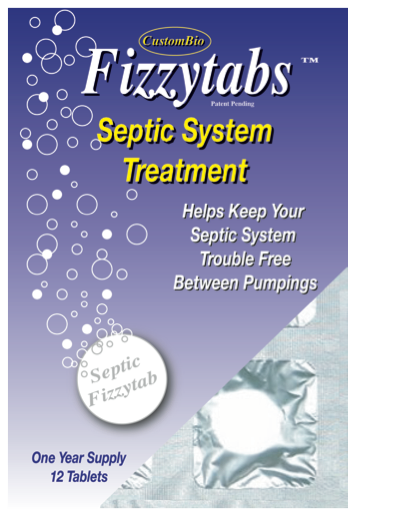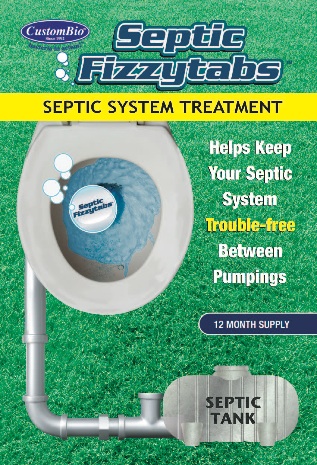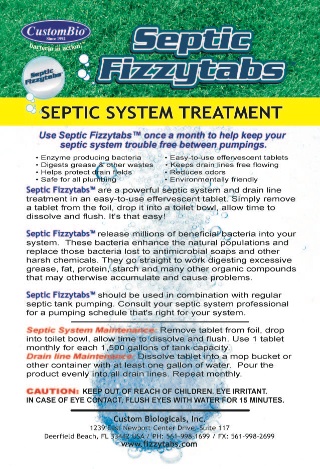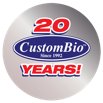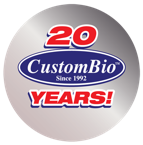Download ORIGINAL Card Front Download ORIGINAL Card Back
Download NEW 2009 Card Front 2009-new-Septic-Fizzytabs-B.pdf
Download Trifold (pdf) Download Trifold (text only .doc)
(text below)
Download Septic Fizzytab Distributor Info (text below)
Download Mass Title V VIEW CASE STUDIES
SEPTIC TRIFOLD - TEXT:
OUTSIDE TEXT
People & Pipe Friendly!
Regular use of Septic Fizzytabs™ will help:
• Reduce buildup on pipes
• Prevent Backup
• Replenish bacterial populations
• Keep your tank operating efficiently
• Protect your drainfield
• Reduce Odors
Septic Fizzytabs™ are the
natural approach to septic system maintenance.
This powerful formula is a highly concentrated blend of microorganisms scientifically chosen for their enhanced ability to digest the grease, fats, oils, proteins, starches, detergents and other organic wastes that accumulate in drain pipes, septic tanks, and drain fields.
World Renowned Microbiologist
Dr. Clarence L. Baugh, Ph.D.
Developer of the
Septic Fizzytabs™ Bacteria
Good Housekeeping Tips!
(to protect your septic system)
1. Have your tank inspected and pumped every 3-6 years (Use the schedule recommended by your local septic tank pumper.
2. Know where your septic system is located so that you can visually notice changes of appearance on the surface.
3. Do not use a garbage disposal! Disposal’s contribute to the accumulation of solids and leads to more frequent required pumping.
4. Do not plant trees or shrubs on or around the septic tank or drain field. The plants will block the sun, reducing the evaporation ability and the roots can damage the field.
5. DO plant grass on the field. Grassy vegetation helps the soil absorb water.
6. Do NOT dispose of hazardous chemicals down your drain, especially pesticides, paints, gas, etc.
7. Limit the amounts of bleach and strong disinfectants.
8. Do not flush sanitary pads, tampons, cigarettes or other small objects.
9. Schedule laundry loads evenly throughout the week. Try not to do laundry all in one day. Even water flow is much easier for the system.
10. Limit excess water
a. Install efficient, low flow toilets and shower heads
b. Fix leaky faucets and showers
c. Fix toilets that run continuously
d. Do not allow roof gutters to drain into,
on or near the septic system.
11. Do not park cars or heavy equipment on the tank or drain field. This compacts the soil and reduces the absorption.
12. Use Septic Fizzytabs ™ once a month!
(once a week for slow or problem fields)
septic tank n (ca1902):
A tank in which the solid matter of continuously flowing sewage is disintegrated by bacteria.
INSIDE TEXT
This saying may never have been more true than with the household septic system. In fact, most people never consider their septic system until there is a problem.
This guide will help you prevent septic problems. It explains the basic parts of your septic system (drainpipes, septic tank, drainage area) and how they work, the problems that can occur when they are neglected, and how a little basic maintenance can help prevent major repair bills.
Drainpipes
[Drainpipe n(1857): a pipe for drainage] Not always considered part of the septic system, drainpipes serve a critical function. They carry the waste from sinks, baths, and toilets to the septic tank.
Over time, drainpipes accumulate waste. Their surfaces become covered with grease, soap and other materials. As build up occurs, pipes begin to lose diameter and water flow becomes restricted. This results in slow drains and clogged pipes.
Once a clog happens, the standard remedy is dangerous caustic chemicals or expensive mechanical snaking. Unfortunately, these methods only partially open pipes, leaving them susceptible to further clogging.
Septic Tank
[Septic Tank n(ca1902): a tank in which the solid matter of continuously flowing sewage is disintegrated by bacteria”]
In other words, your septic tank is the heart of your septic system and functions as a miniature waste treatment plant.
As waste enters the septic tank it separates into distinct layers: (see illustration to the right A.1)
• The top layer is known as the scum layer [“scum n: extraneous matter or impurities risen to or formed on the surface of a liquid often as a foul filmy covering”] and generally consists of digestible organic material.
• The middle layer consists of fairly clean water. It is from this layer that water leaves the septic tank and enters the drainage area.
• The bottom layer, also known as the sludge layer, [“sludge n: a muddy or slushy mass, deposit, or sediment (such) as precipitated solid matter produced by water and sewage treatment processes”] is made up primarily of inorganic and other indigestible materials.
In your operating system, the natural bacteria populations digest the scum layer and only clean water from the middle layer leaves the septic tank and passes into the drainage area.
In a problem trap, the scum layer or sludge layer becomes so large that solids are allowed out of the trap into the drainage area. This can happen for a number of reasons.
If the problem is excessive scum, it is most likely the result of insufficient bacterial populations. This can be a result of simple overloading where there are large numbers of bacteria but too much waste is entering the tank. It can also result from systematic destruction of the natural bacteria by the use of common household chemicals.
Chemicals such as bleach, toilet bowl sanitizers, acidic or caustic cleaners, drain openers, bathtub and grout cleansers, and others destroy bacteria, thus reducing the efficiency of your septic tank.
Unlike excessive scum, sludge buildup does not necessarily mean your system is not working properly. As we mentioned previously, sludge contains inorganic and other indigestible materials. These materials will continue to accumulate even in a properly working system and will need to be removed by a professional septic pumper.
Drainage Area
From leach fields to cess pools, there are many styles of drainage areas that all work on the same principle. They disperse the water leaving the septic tank over a large area so that it is better absorbed by the soil.
Usually a drainage area will consist of a pipe, or network of pipes, that are perforated to allow water to escape. These pipes often rest on varying layers of sand and gravel with the larger stones closer to the pipe.
Under normal conditions, the leach field only receives clean water from the septic tank but, as we have seen, in overload or inefficient conditions, emulsified grease, scum and solids are allowed to leave the septic tank and enter the leach field. This material begins to quickly accumulate in the small pores of the sand and gravel, impeding water flow and water absorption into the soil. This can lead to further problems such as standing water, especially after rain, and excessive odor. If left untreated entirely, this condition will lead to complete failure of the septic system including ruined leach fields and overflowing septic tanks.
Replacement costs of leach fields vary significantly, but even the smallest systems can cost several thousand dollars to replace.
• Easy To Use
• Tackles Tough Odors
• Safe For All Plumbing
• Keeps Drain Lines Free Flowing
• Affordable Weekly Maintenance
• Stores Easily & With No Powder Residue
• Digests Grease & Other Wastes
• Helps Protect Drain Fields
• Enzyme Producing Bacteria
• Environmentally Friendly
SEPTIC FIZZYTABS - Distributor info TEXT:
SEPTIC FIZZYTABS™
The addition of bacteria grown in the laboratory is known as bioaugmentation. While this seems a fancy word, it really means the addition of bacteria. Bacteria are needed in a septic system for several reasons:
Grease – the intestinal bacteria that usually degrade the organic material in a septic system do not have the ability to degrade greases, fats and oils that are used in cooking. That is because these organisms only come in contact with digested fats, oils and grease. The addition of the bacteria in Septic Fizzytabs™ allows the greases, fats and oils to degrade. Once the degradation process begins, the indigenous bacteria continue to degrade the remaining organic materials.
Replacement – In today’s world, homeowners are aggressively trying to kill bacteria with anti-microbial soaps, shampoos, dishwater detergents and even pharmaceutical antibiotics. These products all end up in the septic tank and a lot of these products are very effective. Regular dosing of the bacteria in Septic Fizzytabs™ will help restore the biological component of the septic tank to optimal conditions.
Field Protection – In addition to antimicrobials, regular soaps and emulsifiers can be harmful to a leaching field. These soaps can bypass (and allow emulsified grease to bypass) the septic tank, which is designed to stop grease from entering the field. The grease and the soap “scum” can build up in the field and cause the field to lose drainage capacity. When enough of the field is stopped up, the field will become slow and eventually fail. The cost of field replacement is EXTREME in comparison to regular tank pumping and use of Septic Fizzytabs™.
APPLICATION RATES:
MONTHLY: For normal, single family homes, use 1 Septic Fizzytab™ per month.
WEEKLY: For slow systems, mild odor problems and/or mild problem fields, use 1 Septic Fizzytab™ per week.
DAILY for 30 days: For Extremely SLOW systems, problem fields or extreme odor fields, use 1 Septic Fizzytab™ per day for 30 days, then use 1 Septic Fizzytab™ per week.
Packaging Benefits –
Distributor Benefits - “Truck Friendly”
Freezing or hot temperatures in vehicle will not harm the bacteria in Fizzytabs™.
Marketable packaging – clean and professional
Labels are inside – package will not be ruined from wet or dirty hands.
Light weight – easy to carry in truck, easy to demo to customer – LESS money to ship.
Envelopes are available to ship next years supply without manpower of a delivery!
Available in packaging to meet multiple applications and markets.
YOUR contact information printed on the package – the customer re-orders with you!
Customer Benefits - “Housewife Friendly”
Easy to open, easy to store
EASY TO USE: no mixing of powder, no measuring of liquid.
Simply cut open the foil pouch, drop it in the toilet, watch it fizz, and flush it!
Requires very little cabinet space – can cleanly fit in with towels and linens.
Does not leave powder residue or liquid “ring” in cabinet.
This page and its contents are copyright 2008-2011, Custom Biologicals, inc.
Septic Fizzytabs and CustomBio are Trademarks of Custom Biologicals, Inc.


